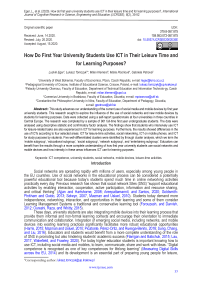How do first year university students use ICT in their leisure time and for learning purposes?
Автор: Ludvík Eger, Łukasz Tomczyk, Milan Klement, Mária Pisoňová, Gabriela Petrová
Журнал: International Journal of Cognitive Research in Science, Engineering and Education @ijcrsee
Рубрика: Original research
Статья в выпуске: 2 vol.8, 2020 года.
Бесплатный доступ
This study advances our understanding of the current use of social media and mobile devices by first year university students. This research sought to explore the influence of the use of social networks and new mobile devices by students for learning purposes. Data were collected using a self-report questionnaire at four universities in three countries in Central Europe. The research was completed by a sample of 961 full-time first year undergraduate students. The data were analysed using descriptive statistic and confirmatory factor analysis. The findings show that students who intensively use ICT for leisure-related tasks are also experienced in ICT for learning purposes. Furthermore, the results showed differences in the use of ICTs according to four selected areas: ICT for leisure-time activities, social networking, ICT on mobile phones, and ICT for study purposes by students. Five well-differentiated clusters were identified by through cluster analysis, which we term the ‘mobile subgroup’, ‘educational subgroup’, ‘social subgroup’, ‘network subgroup’, and ‘entertaining subgroup’. Educators can benefit from the results through a more complete understanding of how first year university students use social networks and mobile devices and how intensity in these areas influences ICT use for learning purposes.
Ict competence, university students, social networks, mobile devices, leisure-time activities
Короткий адрес: https://sciup.org/170198582
IDR: 170198582 | УДК: 379.8-057.875 | DOI: 10.5937/IJCRSEE2002035E
Текст научной статьи How do first year university students use ICT in their leisure time and for learning purposes?
Social networks are spreading rapidly with millions of users, especially among young people in the EU countries. Use of social networks in the educational process can be considered a potentially powerful educational tool because today’s students spend much time in online networking activities practically every day. Previous research has shown that social network Sites (SNS) “support educational activities by enabling interaction, cooperation, active participation, information and resource sharing, and critical thinking” ( Ajjan and Hartshorne, 2008 ; Areepattamannil, and Santos, 2020 ; Goldsmith Pinkham and Guido, 2013 ; Selwyn, 2007 , Mazman and Usluel, 2010 ). Students today demand more independence, networking, interaction, and opportunities in their learning and some of them consider Learning Management Systems a traditional and conservative learning tool ( Forouzesh, and Darvish, 2012 ; Oureshi, Raza, and Whitty, 2015 ).
These days, university students are also integrating mobile devices into their learning process that provide them informal and non-formal learning contexts and encourage their orientation to immediate communication and collaboration. Integration of emerging social media, including networks, and mobile devices into existing learning practices significantly facilitates more robust educational opportunities ( Harris, 2015 ; Mazman and Usluel, 2010 ; Picatoste, Pérez-Ortiz, and Ruesga-Benito, 2018 ; Sung, Chang, and Liu, 2016 ). Educators and students would benefit from a more complete understanding of the role of SNS in promoting but also hindering students’ academic success ( Flanigan and Babchuk, 2015 ; Lau, 2017 , Wakefield, and Frawley, 2020 ). For today higher education students is important knowing how to use ICT, including social media and mobiles, to learn, communicate, share and work with ideas. “Digital competence is recognised as one of key competences for lifelong learning” ( Measuring Digital Skills across the EU, 2014 ) and its development is an essential part of preparing young people for leisure,
learning, work and communication in knowledge society.
The rapid development of ICT has had considerable and visible impact on current educational sector ( Flanigan and Babchuk, 2015 ; Goodfellow, 2011 ; Juhaňák et al., 2019 ; Mazman and Usluel, 2010 ; Stošić and Stošić, 2015 ; Wu and Tsai, 2006 ). In the last two decades, researchers have largely explored learners’ attitudes toward new media. However, comparatively few studies have investigated students’ attitudes towards using the Internet for different purposes in their formal and informal learning. This especially applies to the countries of Central Europe, where the dynamic development of ICT use started later than in the Western European countries ( Eger and Egerova, 2013 ; Klement, 2013 ; Tomczyk and Kopecký, 2016 ; Slechtova, 2015 ). Therefore, one of the major purposes of the present study is to assess first year university students’ ICT attitudes with a special focus on the use of SNS and mobiles (smartphones for communication purpose). Our next aim is to provide a deeper understanding of how first year university students really use ICT in their daily life.


